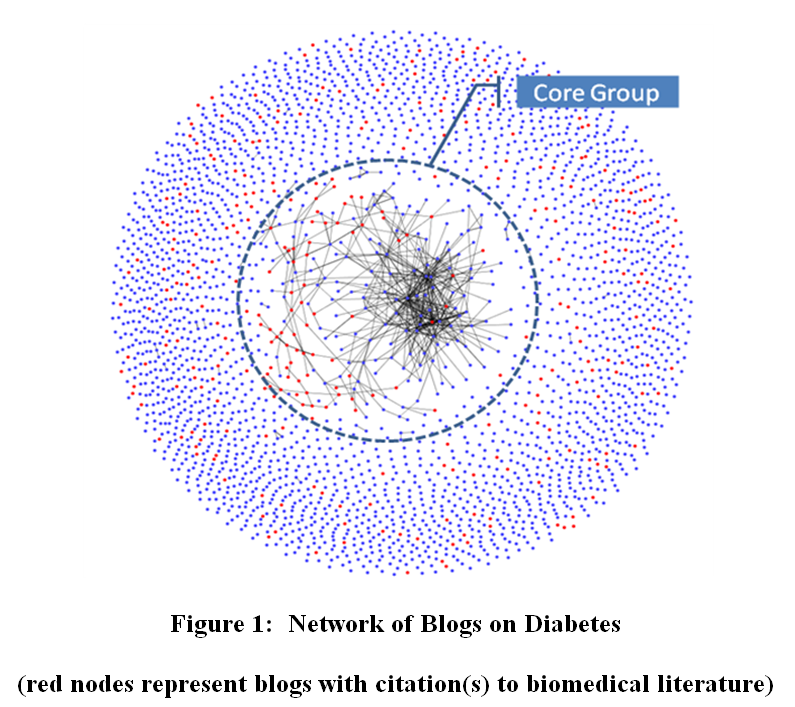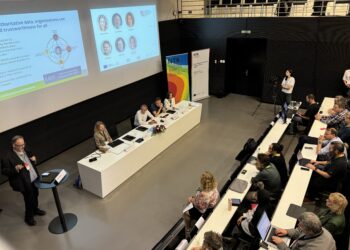
In the world of science blogging, there are those who cite the literature, those who don’t, and never the twain shall meet. This is the main finding from a network analysis of blogs about diabetes.
The article, “Investigating biomedical research literature in the blogosphere: a case study of diabetes and glycated hemoglobin (HbA1c)” by Anatoliy Gruzd and others, appears in the January 2012 issue of the Journal of the Medical Library Association.
Using a combination of Web mining, content analysis, and social network analysis, the researchers analyzed how bloggers incorporated the medical literature in their blog posts.
They report that just 10% of the 3,005 blogs on diabetes cited the biomedical literature. The most influential blogs, however, were not the ones that cited the literature. As measured by in-links (hyperlinks from other blogs), the most influential blogs were written by diabetes patients who largely ignored the scientific literature and cited other non-authoritative blogs. Even health resources, written in nonspecialist language and designed specifically for patient education, were being largely ignored. Just 6% of diabetes blogs linked to MedlinePlus, a patient-oriented site provided by the US National Library of Medicine and National Institutes of Health.
[O]nly a small portion of published articles is cited in the blogosphere. This finding may reflect the fact that bloggers and blog readers are not using blogs to discuss or look for health information, but for other purposes such as sharing personal stories and emotional support
A content analysis of those blogs that did cite the biomedical literature written, for the most part, by health professionals and librarians. In spite of their best intention to translate the biomedical literature for the public, their work remains largely uncited by diabetes patient bloggers. To Gruzd, this illustrates a communication gap between health professionals and patients.
The social network analysis of diabetes blogs illustrates the sociological principle of homophily, the tendency of individuals with similar socio-economic status, preferences, or behaviors to form tight relational bonds that limit their interaction with those outside their network.
While homophily helps build trust and cohesion to groups, it can also help to isolate them. The social network analysis of diabetes blogs may suggest that new developments in medicine may simply not be reaching bloggers and their readers.
If birds of a feather flock together, as the old adage goes, the same can be said about bloggers.

Discussion
15 Thoughts on "Birds of a Feather Blog Together"
Two points to make, not at all connected.
First, the illustration from the paper is a classic example of one that would be enormously easier to interpret if colour had been used. Red and blue dots would be far more visually parseable than differently shaped dots.
Second, and more important, I’m a bit nonplussed that the most obvious reason for bloggers not citing the peer-reviewed research isn’t even mentioned: they don’t have access to it. It can hardly be surprising that “those blogs that did cite the biomedical literature written, for the most part, by health professionals and librarians” when they are the only groups that can get past paywalls.
You are positing a hypothesis about why bloggers aren’t citing the literature, and you may have hit upon a real limitation of the study. An alternative hypothesis, which I find more convincing, is that most bloggers aren’t taught to cite the literature, have no reputational advantage associated with using citations, and aren’t familiar with the conventions of citation, so are not prone to do it, despite access to PubMed, PMC, MedLine Plus, many archives that make themselves free, news reports, OA megajournals, and so forth (thousands and thousands of free articles and millions of free abstracts and summaries). Health professionals and librarians are taught to cite the literature, have reputational advantages by using the citation form, and are prone to do it.
This gets at what may be a limitation of the study.
In reading through the study, it seems the authors were looking for explicit citation forms (i.e., lists of references). Blogs often use internal links in text rather than explicit citation lists. These links are more of the blogging convention than are lists of references. If the authors didn’t count textual links as citations, then you’re possibly talking about citation cultures (the old world of health professionals and librarians vs. the new world of bloggers) rather than citation rates.
Access to information about diabetes wasn’t the issue here. As you’ll recall, MedLine Plus was mentioned specifically. It is free, but was ignored by 94% of the bloggers.
Kent,
From a quick reading of the paper, I can’t tell exactly what their criteria were for declaring something a “citation”. It sounds like they did a Google Blog Search using the title of the article and the first author’s name. That would mean any mention of both would be found, not just a formal citation. But they would have missed articles that used a different author’s name or linked via text without explicitly mentioning the article’s title.
Regardless, I think it does say something about the medical patient’s interest in the experimental literature. I don’t think it’s an issue of lack of access to the literature. The article set chosen is from 2008 and 2009. Much of that set is likely freely available at this point. It also raises the question of the ability of the general public to read high level experimental results papers without the benefit of extensive training.
But even if we assume the entirety of the paper set is behind a paywall, there is still a significant set of blogs written by people with access who summarize the literature for the layman. The study shows that very few bother to mention or link to those summaries.
Some of this is likely due to the huge gap between research and treatment. Data collected while seeking to understand the fundamental cellular and molecular phenomena behind the disease may not mean all that much to a patient who is interested in new medications or treatments.
But likely, this is simply the nature of blogs. Blogging is a blank slate, and one makes of it what one will. Patient communities are one of the great new developments the internet has given us. These communities may be more about sharing experience and bonding than in keeping up with the latest experimental data.
I think there’s a lot of truth in what you say. As we’ve discussed plenty of time, having access doesn’t make information accessible. I can get to a lot of articles about theoretical mathematics, but damned if I can understand them, much less put them to use.
Ultimately, I think you’re right in both comments — there’s a false expectation that blogging will be academic, and academic blogging tends to be interesting only to other academics.
It is not useful to think of open access primarily as a way to inform the general public. Open access is primarily intended to make the scientific discourse more efficient, in order to boost scientific discovery. Indeed, having access doesn’t make information necessarily accessible to everyone, but not having access guarantees that it isn’t at all.
Interesting. Wouldn’t it be good to have the possibility to do similar anayses by text-mining the scientific literature, across the entire published corpus of journal articles, irrespective of whoever the publisher might be? Analysis of just references won’t quite do; content analysis is needed.
It may well be that homophily is a phenomenon in scientific circles, too, birds of a feather publishing together. Scientists, too, may turn out to be “individuals with similar socio-economic status, preferences, or behaviors who form tight relational bonds that limit their interaction with those outside their network.” Although I would hope such analyses show that interaction with those outside their networks is not limited. Perhaps a difference can be demonstrated between OA and non-OA literature.
homophily — I wonder if my horses, goats, sheep or geese know that word? I have been studying the phenomenum for many years but I call it herd behavior – and it is one of the most primitive (in the mathematical sense) behaviors that maintains the individuals into a herd – they recognize certain other individuals as being members of their herd by some form of “sameness”.
In order you to become a member of herd, the existing members force certain behaviors upon the putative new member, and his instinctive desire to want to belong makes him conform to the demands of the herd. In humans we call it “hazing”, but it occurs in all herd forming-species that I have studied. Anyone who has joined a club, committee or company, or a discussion forum has experienced this.
It is particularly pernicious in internet forums, where the “likeness” is typically likeness of opinion, and likeness of style. Those who oppose the herd, or who dare to question the dogma of the herd, or who fail to behave with the civility or, more commonly, the obnoxiousness accepted by the herd are rejected – by being attacked or ignored – and soon withdraw. The result is that most opinion is expressed into an echo chamber, and reinforced by the agreement of those who have been pre-selected for their agreement. I think that has contributed to the divided and extremist positions of people in this country. Ironically the increased efficiency of communication that the internet affords has caused less actual communication. People who agree aren’t communicating; they are just chanting dogma, and people whose words are just naming-calling (etc) aren’t communicating either.
I agree with much of this (no homophily intended!). The herd tendency leads to ‘echo-chambers’ of opinions, ideas, et cetera. The search engine or search algorithm that could help us out of this homophily universe, would be one that served up results that show the way to the polar opposite of the input question. I’m not aware of such a search algorithm existing yet.
Are you suggesting that people should not have opinions? In any case your proposed algorithm is nonsensical, which is probably why it does not exist. But if you want an algorithm that, when I enter the search term “dry rot,” produces everything that does not mention that, I can create one. Google Scholar has just such an exclusion feature but Google appears not to.
David, do you read in my comment that people should have no opinions? I mean quite the opposite. And of course the idea of my proposed algorithm is nonsense. I just want to illustrate, indeed with an exaggeration, the notion that opposing views and opposing observations enrich the discourse and are far more valuable than agreement before its due time, and homophily does not exactly encourage that. I’m taking a leaf out of Popper’s book. Verifying is good, but trying to falsify is better. By the way, excluding a term is not the same as producing its opposite.
This study fits well with the conclusions seen from an earlier study we covered back in 2010. That study showed that blogs written by scientists tend to create insular communities consisting of other scientists, rather than the general public.


